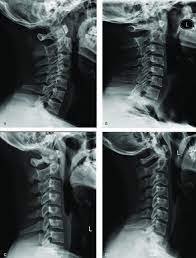What is neck curve?
The ideal neck curve is 33 degrees. Simply put; the neck curve should be shaped like a C or a banana. The neck curve is also known as cervical lordosis. The apex of the curve is forward facing; meaning it should be towards your nose when looking from a side profile. (see picture below - top left)
What’s so important about it though? Why do so many people who are suffering from pain happens to also have a compromised neck curve?
1. Spinal Support: The neck curve helps balance the weight of the head and provides support to the cervical spine. It helps distribute the forces and pressures experienced by the neck during various activities, reducing the risk of strain or injury.
2. Shock Absorption: The natural curve of the neck acts as a shock absorber, cushioning the impact of everyday movements and activities such as walking, running, and jumping. This helps protect the delicate structures of the cervical spine, including the vertebrae, discs, nerves, and muscles.
3. Range of Motion: The neck curve allows for a greater range of motion, enabling us to turn, tilt, and flex our heads comfortably. It facilitates smooth movement and flexibility, which are essential for daily activities like driving, looking around, and maintaining eye contact.
4. Nerve Function: The cervical curve helps maintain proper alignment of the spinal nerves, which exit the spinal cord through small openings in the vertebrae called intervertebral foramina. A healthy neck curve helps ensure optimal nerve function, promoting efficient communication between the brain and the rest of the body.
5. Postural Alignment: The neck curve contributes to overall postural alignment. When the neck curve is properly maintained, it helps align the head, neck, and spine in a neutral position, minimizing stress on the surrounding structures and reducing the risk of chronic pain, headaches, and other postural issues.
Trauma can potentially be the biggest affect to the natural curve of the neck. Injuries like whiplash or direct impact can cause misalignment; resulting in a loss of the normal curve. The five things listed above can potentially be all affected; not only in the neck but in the rest of the spine as well. See picture below; only one xray represents a normal neck curve - left upper corner. The rest of the neck xrays exhibit a compromised spine subject to varying ailing symptoms. With activities of daily living compounding onto a misaligned spine; pain and neurological symptoms can arise.
Have you been living with symptoms? Do you want to see if you are a candidate to benefit from NUCCA? Contact us for your consultation.
For more information check out: My Misalignment
